CMNS253 Assignment: Analysis of Digital Culture Concepts in Software
VerifiedAdded on 2022/09/14
|9
|1989
|18
Homework Assignment
AI Summary
This document presents a completed assignment for CMNS253, focusing on the analysis of digital culture concepts within a chosen software application. The assignment, worth 30 marks, requires the selection of six key terms from a provided list (including algorithms, web 2.0, filter bubbles, datafication, monetization, and cyberwarfare) and a corresponding analysis of how these concepts manifest within the selected software. The solution includes an introduction outlining the scope of digital culture and the chosen topics, followed by detailed paragraphs dedicated to each of the selected terms. Each paragraph, between 250 and 300 words, provides an in-depth exploration of the chosen concept and its relevance to the software, supported by research and examples. The assignment concludes with a summary of the findings and a list of cited references. This assignment is designed to demonstrate an understanding of digital culture's impact on software and technology.
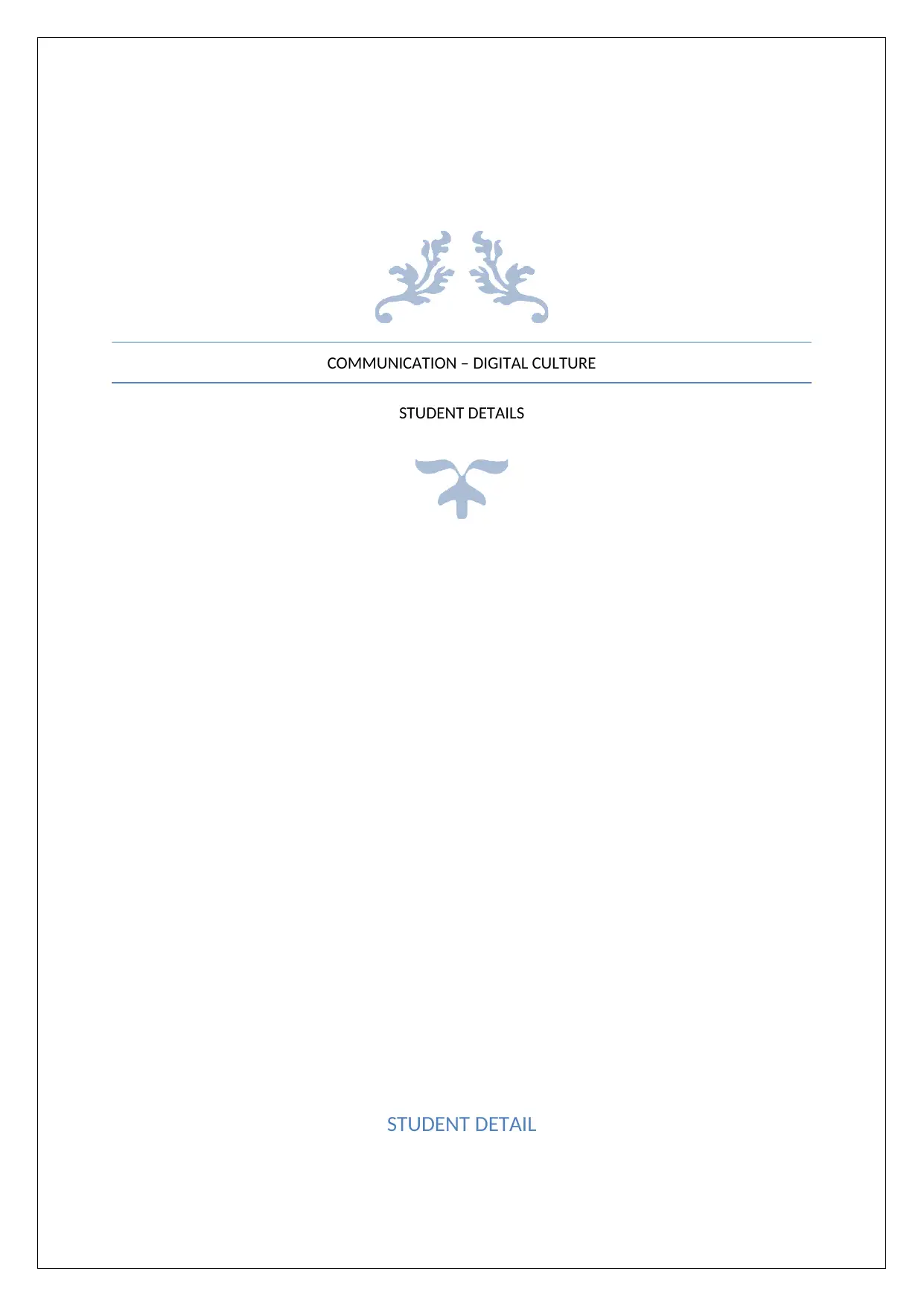
COMMUNICATION – DIGITAL CULTURE
STUDENT DETAILS
STUDENT DETAIL
STUDENT DETAILS
STUDENT DETAIL
Paraphrase This Document
Need a fresh take? Get an instant paraphrase of this document with our AI Paraphraser
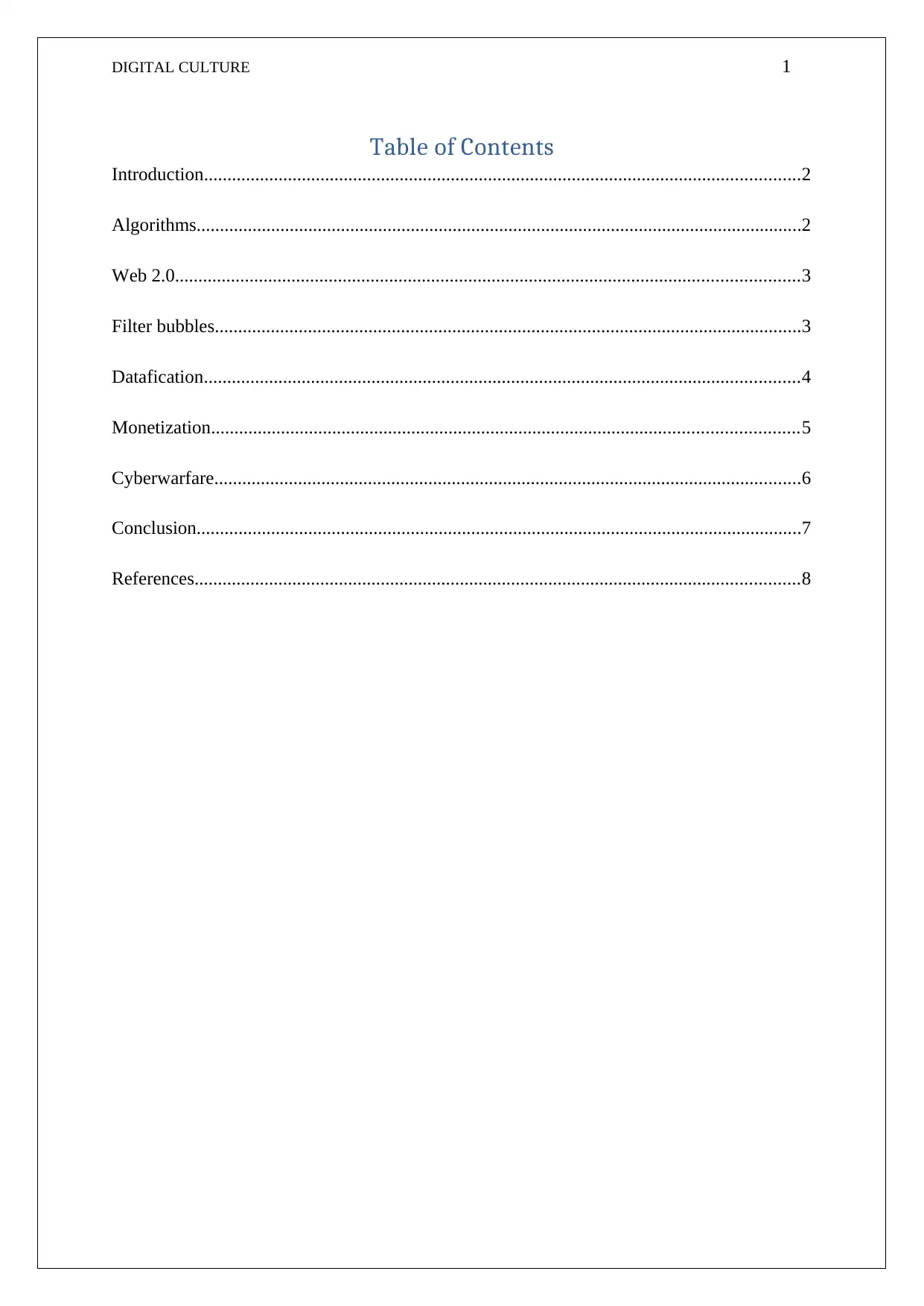
DIGITAL CULTURE 1
Table of Contents
Introduction................................................................................................................................2
Algorithms..................................................................................................................................2
Web 2.0......................................................................................................................................3
Filter bubbles..............................................................................................................................3
Datafication................................................................................................................................4
Monetization..............................................................................................................................5
Cyberwarfare..............................................................................................................................6
Conclusion..................................................................................................................................7
References..................................................................................................................................8
Table of Contents
Introduction................................................................................................................................2
Algorithms..................................................................................................................................2
Web 2.0......................................................................................................................................3
Filter bubbles..............................................................................................................................3
Datafication................................................................................................................................4
Monetization..............................................................................................................................5
Cyberwarfare..............................................................................................................................6
Conclusion..................................................................................................................................7
References..................................................................................................................................8
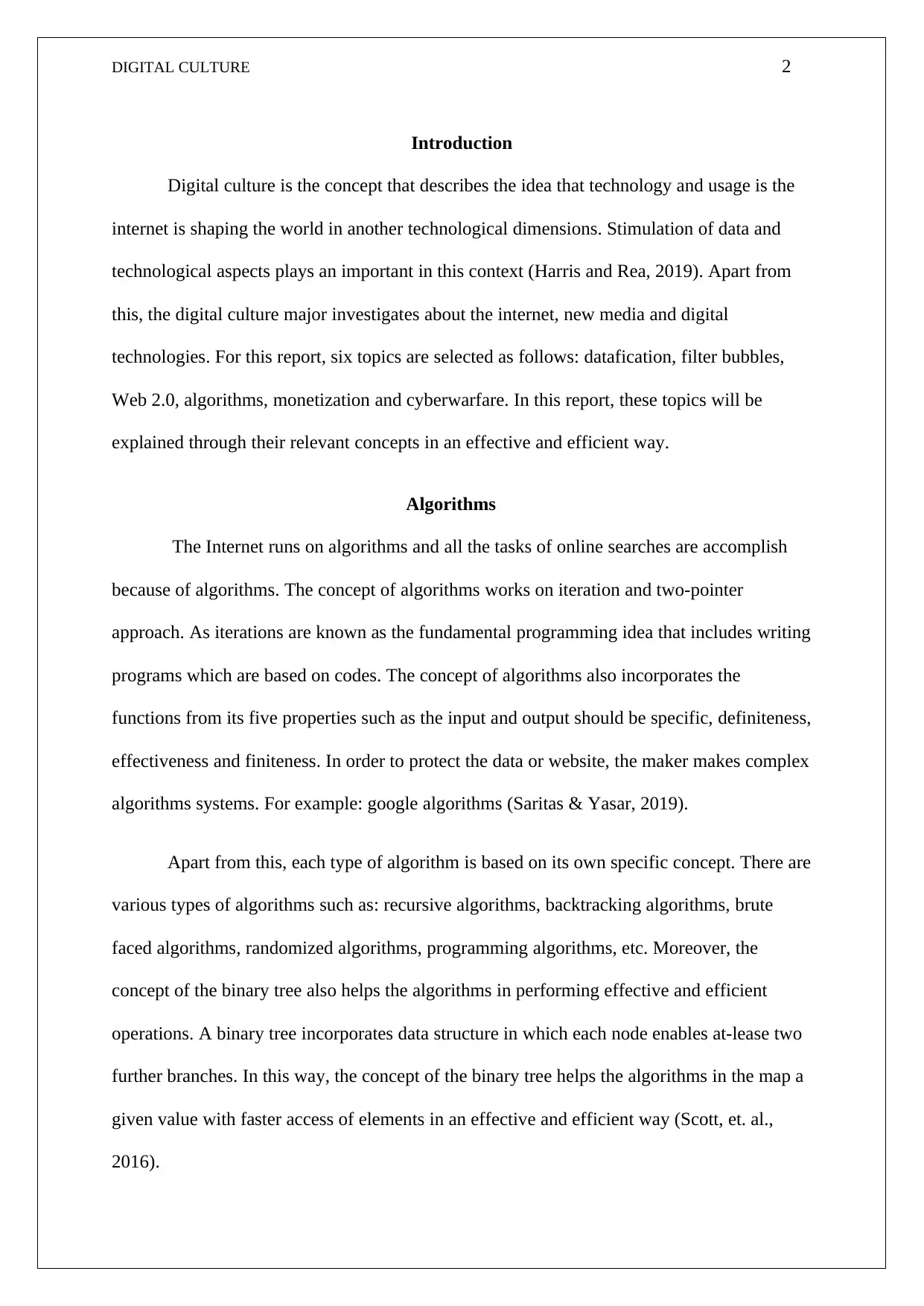
DIGITAL CULTURE 2
Introduction
Digital culture is the concept that describes the idea that technology and usage is the
internet is shaping the world in another technological dimensions. Stimulation of data and
technological aspects plays an important in this context (Harris and Rea, 2019). Apart from
this, the digital culture major investigates about the internet, new media and digital
technologies. For this report, six topics are selected as follows: datafication, filter bubbles,
Web 2.0, algorithms, monetization and cyberwarfare. In this report, these topics will be
explained through their relevant concepts in an effective and efficient way.
Algorithms
The Internet runs on algorithms and all the tasks of online searches are accomplish
because of algorithms. The concept of algorithms works on iteration and two-pointer
approach. As iterations are known as the fundamental programming idea that includes writing
programs which are based on codes. The concept of algorithms also incorporates the
functions from its five properties such as the input and output should be specific, definiteness,
effectiveness and finiteness. In order to protect the data or website, the maker makes complex
algorithms systems. For example: google algorithms (Saritas & Yasar, 2019).
Apart from this, each type of algorithm is based on its own specific concept. There are
various types of algorithms such as: recursive algorithms, backtracking algorithms, brute
faced algorithms, randomized algorithms, programming algorithms, etc. Moreover, the
concept of the binary tree also helps the algorithms in performing effective and efficient
operations. A binary tree incorporates data structure in which each node enables at-lease two
further branches. In this way, the concept of the binary tree helps the algorithms in the map a
given value with faster access of elements in an effective and efficient way (Scott, et. al.,
2016).
Introduction
Digital culture is the concept that describes the idea that technology and usage is the
internet is shaping the world in another technological dimensions. Stimulation of data and
technological aspects plays an important in this context (Harris and Rea, 2019). Apart from
this, the digital culture major investigates about the internet, new media and digital
technologies. For this report, six topics are selected as follows: datafication, filter bubbles,
Web 2.0, algorithms, monetization and cyberwarfare. In this report, these topics will be
explained through their relevant concepts in an effective and efficient way.
Algorithms
The Internet runs on algorithms and all the tasks of online searches are accomplish
because of algorithms. The concept of algorithms works on iteration and two-pointer
approach. As iterations are known as the fundamental programming idea that includes writing
programs which are based on codes. The concept of algorithms also incorporates the
functions from its five properties such as the input and output should be specific, definiteness,
effectiveness and finiteness. In order to protect the data or website, the maker makes complex
algorithms systems. For example: google algorithms (Saritas & Yasar, 2019).
Apart from this, each type of algorithm is based on its own specific concept. There are
various types of algorithms such as: recursive algorithms, backtracking algorithms, brute
faced algorithms, randomized algorithms, programming algorithms, etc. Moreover, the
concept of the binary tree also helps the algorithms in performing effective and efficient
operations. A binary tree incorporates data structure in which each node enables at-lease two
further branches. In this way, the concept of the binary tree helps the algorithms in the map a
given value with faster access of elements in an effective and efficient way (Scott, et. al.,
2016).
⊘ This is a preview!⊘
Do you want full access?
Subscribe today to unlock all pages.

Trusted by 1+ million students worldwide
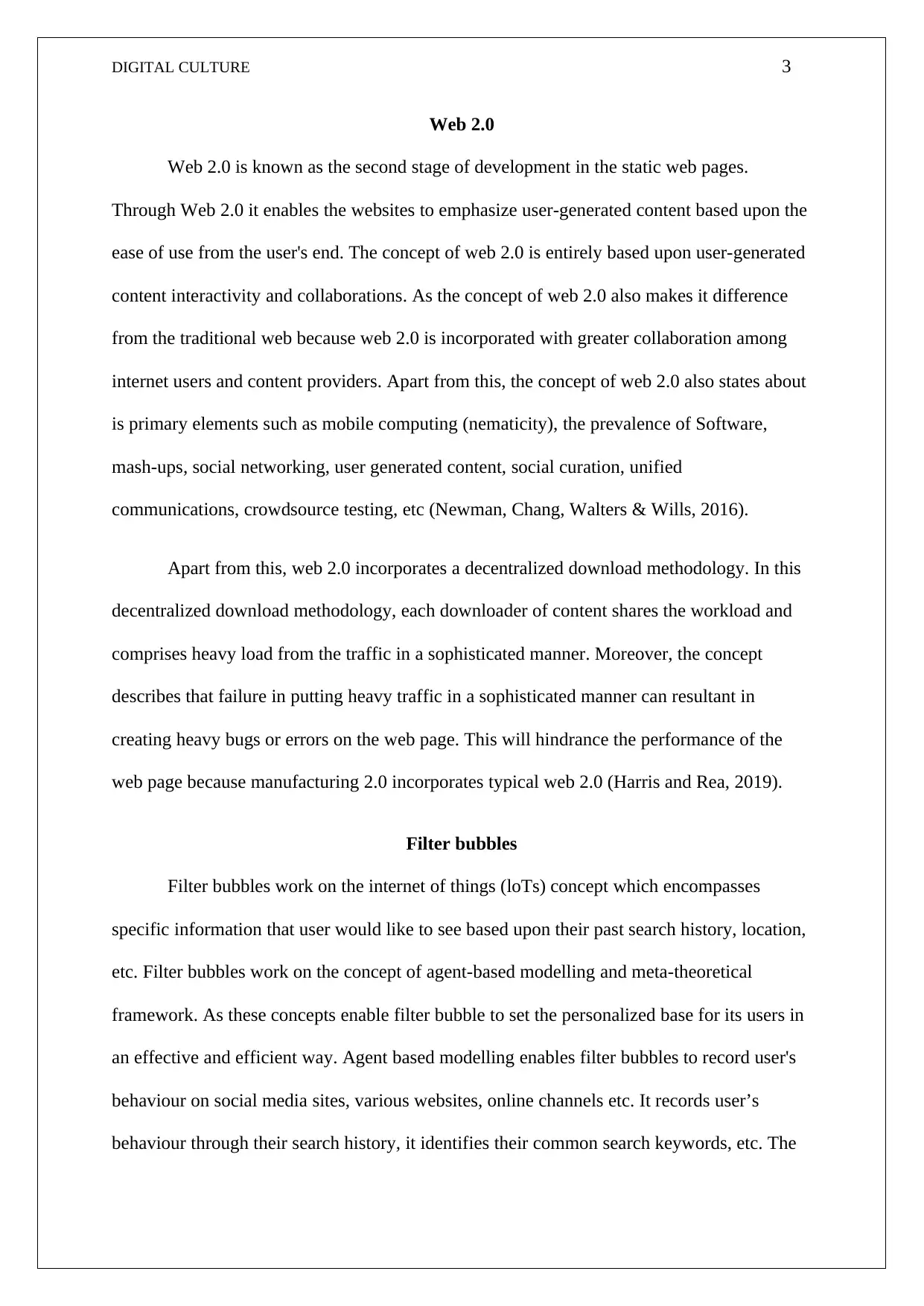
DIGITAL CULTURE 3
Web 2.0
Web 2.0 is known as the second stage of development in the static web pages.
Through Web 2.0 it enables the websites to emphasize user-generated content based upon the
ease of use from the user's end. The concept of web 2.0 is entirely based upon user-generated
content interactivity and collaborations. As the concept of web 2.0 also makes it difference
from the traditional web because web 2.0 is incorporated with greater collaboration among
internet users and content providers. Apart from this, the concept of web 2.0 also states about
is primary elements such as mobile computing (nematicity), the prevalence of Software,
mash-ups, social networking, user generated content, social curation, unified
communications, crowdsource testing, etc (Newman, Chang, Walters & Wills, 2016).
Apart from this, web 2.0 incorporates a decentralized download methodology. In this
decentralized download methodology, each downloader of content shares the workload and
comprises heavy load from the traffic in a sophisticated manner. Moreover, the concept
describes that failure in putting heavy traffic in a sophisticated manner can resultant in
creating heavy bugs or errors on the web page. This will hindrance the performance of the
web page because manufacturing 2.0 incorporates typical web 2.0 (Harris and Rea, 2019).
Filter bubbles
Filter bubbles work on the internet of things (loTs) concept which encompasses
specific information that user would like to see based upon their past search history, location,
etc. Filter bubbles work on the concept of agent-based modelling and meta-theoretical
framework. As these concepts enable filter bubble to set the personalized base for its users in
an effective and efficient way. Agent based modelling enables filter bubbles to record user's
behaviour on social media sites, various websites, online channels etc. It records user’s
behaviour through their search history, it identifies their common search keywords, etc. The
Web 2.0
Web 2.0 is known as the second stage of development in the static web pages.
Through Web 2.0 it enables the websites to emphasize user-generated content based upon the
ease of use from the user's end. The concept of web 2.0 is entirely based upon user-generated
content interactivity and collaborations. As the concept of web 2.0 also makes it difference
from the traditional web because web 2.0 is incorporated with greater collaboration among
internet users and content providers. Apart from this, the concept of web 2.0 also states about
is primary elements such as mobile computing (nematicity), the prevalence of Software,
mash-ups, social networking, user generated content, social curation, unified
communications, crowdsource testing, etc (Newman, Chang, Walters & Wills, 2016).
Apart from this, web 2.0 incorporates a decentralized download methodology. In this
decentralized download methodology, each downloader of content shares the workload and
comprises heavy load from the traffic in a sophisticated manner. Moreover, the concept
describes that failure in putting heavy traffic in a sophisticated manner can resultant in
creating heavy bugs or errors on the web page. This will hindrance the performance of the
web page because manufacturing 2.0 incorporates typical web 2.0 (Harris and Rea, 2019).
Filter bubbles
Filter bubbles work on the internet of things (loTs) concept which encompasses
specific information that user would like to see based upon their past search history, location,
etc. Filter bubbles work on the concept of agent-based modelling and meta-theoretical
framework. As these concepts enable filter bubble to set the personalized base for its users in
an effective and efficient way. Agent based modelling enables filter bubbles to record user's
behaviour on social media sites, various websites, online channels etc. It records user’s
behaviour through their search history, it identifies their common search keywords, etc. The
Paraphrase This Document
Need a fresh take? Get an instant paraphrase of this document with our AI Paraphraser
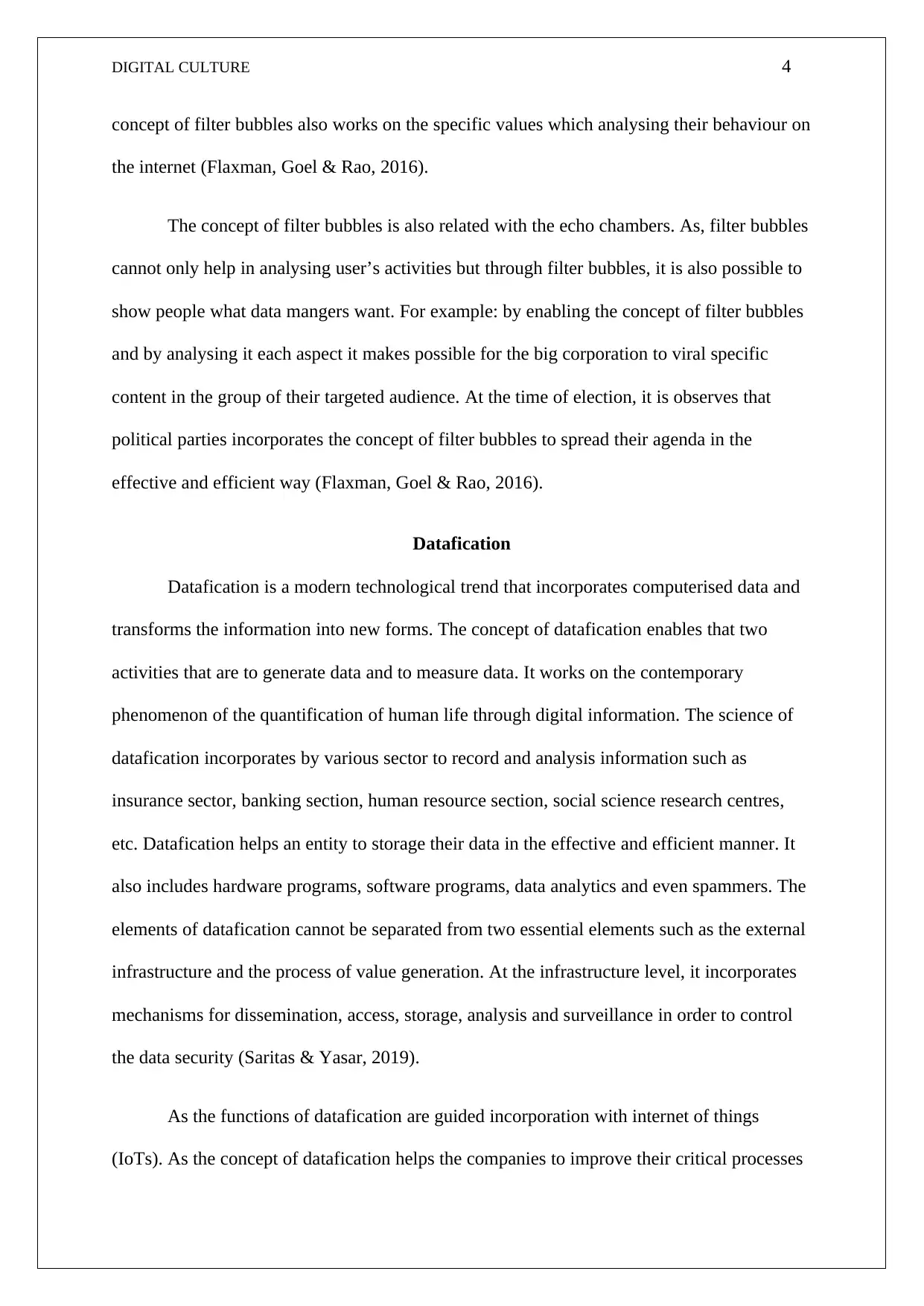
DIGITAL CULTURE 4
concept of filter bubbles also works on the specific values which analysing their behaviour on
the internet (Flaxman, Goel & Rao, 2016).
The concept of filter bubbles is also related with the echo chambers. As, filter bubbles
cannot only help in analysing user’s activities but through filter bubbles, it is also possible to
show people what data mangers want. For example: by enabling the concept of filter bubbles
and by analysing it each aspect it makes possible for the big corporation to viral specific
content in the group of their targeted audience. At the time of election, it is observes that
political parties incorporates the concept of filter bubbles to spread their agenda in the
effective and efficient way (Flaxman, Goel & Rao, 2016).
Datafication
Datafication is a modern technological trend that incorporates computerised data and
transforms the information into new forms. The concept of datafication enables that two
activities that are to generate data and to measure data. It works on the contemporary
phenomenon of the quantification of human life through digital information. The science of
datafication incorporates by various sector to record and analysis information such as
insurance sector, banking section, human resource section, social science research centres,
etc. Datafication helps an entity to storage their data in the effective and efficient manner. It
also includes hardware programs, software programs, data analytics and even spammers. The
elements of datafication cannot be separated from two essential elements such as the external
infrastructure and the process of value generation. At the infrastructure level, it incorporates
mechanisms for dissemination, access, storage, analysis and surveillance in order to control
the data security (Saritas & Yasar, 2019).
As the functions of datafication are guided incorporation with internet of things
(IoTs). As the concept of datafication helps the companies to improve their critical processes
concept of filter bubbles also works on the specific values which analysing their behaviour on
the internet (Flaxman, Goel & Rao, 2016).
The concept of filter bubbles is also related with the echo chambers. As, filter bubbles
cannot only help in analysing user’s activities but through filter bubbles, it is also possible to
show people what data mangers want. For example: by enabling the concept of filter bubbles
and by analysing it each aspect it makes possible for the big corporation to viral specific
content in the group of their targeted audience. At the time of election, it is observes that
political parties incorporates the concept of filter bubbles to spread their agenda in the
effective and efficient way (Flaxman, Goel & Rao, 2016).
Datafication
Datafication is a modern technological trend that incorporates computerised data and
transforms the information into new forms. The concept of datafication enables that two
activities that are to generate data and to measure data. It works on the contemporary
phenomenon of the quantification of human life through digital information. The science of
datafication incorporates by various sector to record and analysis information such as
insurance sector, banking section, human resource section, social science research centres,
etc. Datafication helps an entity to storage their data in the effective and efficient manner. It
also includes hardware programs, software programs, data analytics and even spammers. The
elements of datafication cannot be separated from two essential elements such as the external
infrastructure and the process of value generation. At the infrastructure level, it incorporates
mechanisms for dissemination, access, storage, analysis and surveillance in order to control
the data security (Saritas & Yasar, 2019).
As the functions of datafication are guided incorporation with internet of things
(IoTs). As the concept of datafication helps the companies to improve their critical processes
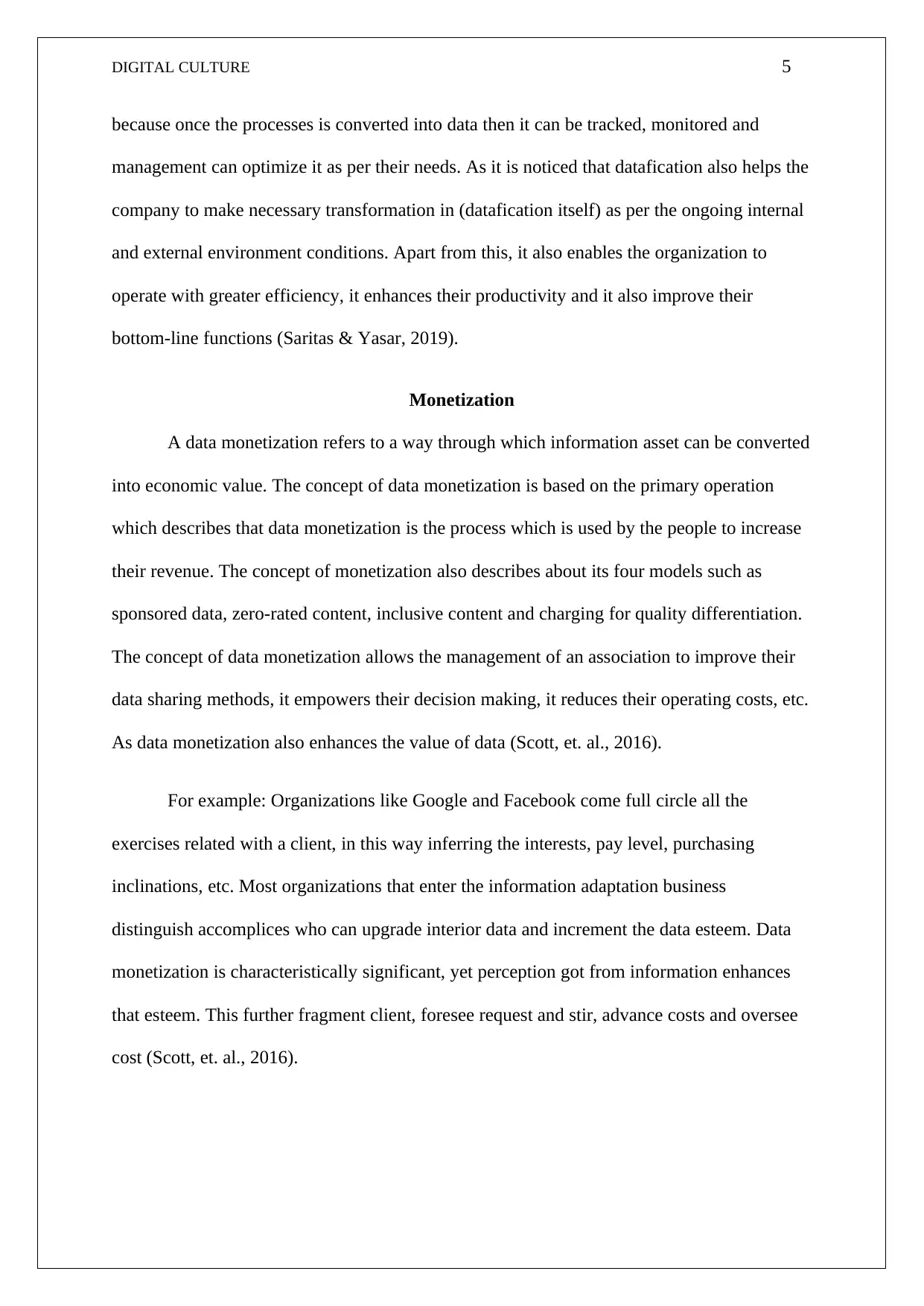
DIGITAL CULTURE 5
because once the processes is converted into data then it can be tracked, monitored and
management can optimize it as per their needs. As it is noticed that datafication also helps the
company to make necessary transformation in (datafication itself) as per the ongoing internal
and external environment conditions. Apart from this, it also enables the organization to
operate with greater efficiency, it enhances their productivity and it also improve their
bottom-line functions (Saritas & Yasar, 2019).
Monetization
A data monetization refers to a way through which information asset can be converted
into economic value. The concept of data monetization is based on the primary operation
which describes that data monetization is the process which is used by the people to increase
their revenue. The concept of monetization also describes about its four models such as
sponsored data, zero-rated content, inclusive content and charging for quality differentiation.
The concept of data monetization allows the management of an association to improve their
data sharing methods, it empowers their decision making, it reduces their operating costs, etc.
As data monetization also enhances the value of data (Scott, et. al., 2016).
For example: Organizations like Google and Facebook come full circle all the
exercises related with a client, in this way inferring the interests, pay level, purchasing
inclinations, etc. Most organizations that enter the information adaptation business
distinguish accomplices who can upgrade interior data and increment the data esteem. Data
monetization is characteristically significant, yet perception got from information enhances
that esteem. This further fragment client, foresee request and stir, advance costs and oversee
cost (Scott, et. al., 2016).
because once the processes is converted into data then it can be tracked, monitored and
management can optimize it as per their needs. As it is noticed that datafication also helps the
company to make necessary transformation in (datafication itself) as per the ongoing internal
and external environment conditions. Apart from this, it also enables the organization to
operate with greater efficiency, it enhances their productivity and it also improve their
bottom-line functions (Saritas & Yasar, 2019).
Monetization
A data monetization refers to a way through which information asset can be converted
into economic value. The concept of data monetization is based on the primary operation
which describes that data monetization is the process which is used by the people to increase
their revenue. The concept of monetization also describes about its four models such as
sponsored data, zero-rated content, inclusive content and charging for quality differentiation.
The concept of data monetization allows the management of an association to improve their
data sharing methods, it empowers their decision making, it reduces their operating costs, etc.
As data monetization also enhances the value of data (Scott, et. al., 2016).
For example: Organizations like Google and Facebook come full circle all the
exercises related with a client, in this way inferring the interests, pay level, purchasing
inclinations, etc. Most organizations that enter the information adaptation business
distinguish accomplices who can upgrade interior data and increment the data esteem. Data
monetization is characteristically significant, yet perception got from information enhances
that esteem. This further fragment client, foresee request and stir, advance costs and oversee
cost (Scott, et. al., 2016).
⊘ This is a preview!⊘
Do you want full access?
Subscribe today to unlock all pages.

Trusted by 1+ million students worldwide
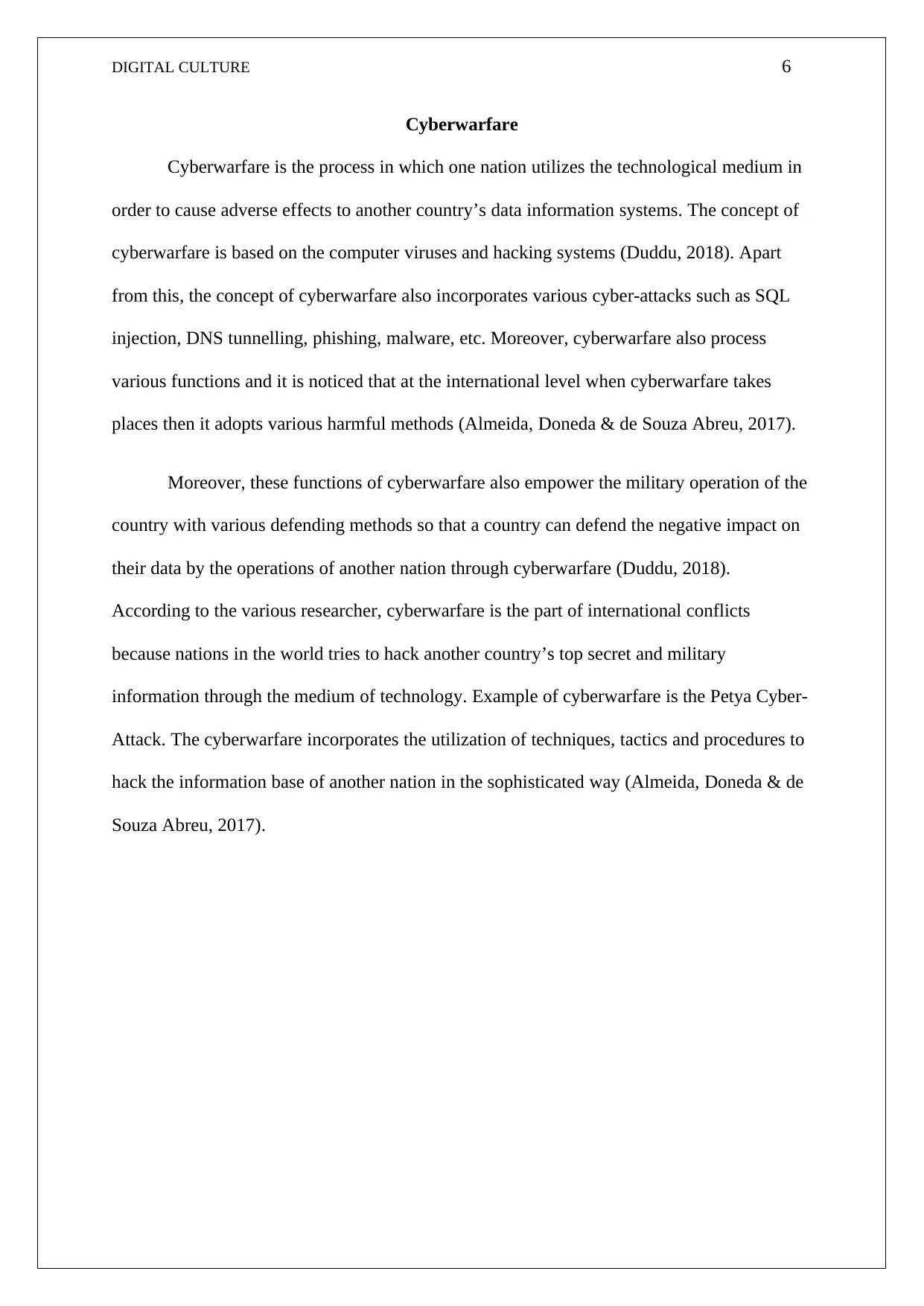
DIGITAL CULTURE 6
Cyberwarfare
Cyberwarfare is the process in which one nation utilizes the technological medium in
order to cause adverse effects to another country’s data information systems. The concept of
cyberwarfare is based on the computer viruses and hacking systems (Duddu, 2018). Apart
from this, the concept of cyberwarfare also incorporates various cyber-attacks such as SQL
injection, DNS tunnelling, phishing, malware, etc. Moreover, cyberwarfare also process
various functions and it is noticed that at the international level when cyberwarfare takes
places then it adopts various harmful methods (Almeida, Doneda & de Souza Abreu, 2017).
Moreover, these functions of cyberwarfare also empower the military operation of the
country with various defending methods so that a country can defend the negative impact on
their data by the operations of another nation through cyberwarfare (Duddu, 2018).
According to the various researcher, cyberwarfare is the part of international conflicts
because nations in the world tries to hack another country’s top secret and military
information through the medium of technology. Example of cyberwarfare is the Petya Cyber-
Attack. The cyberwarfare incorporates the utilization of techniques, tactics and procedures to
hack the information base of another nation in the sophisticated way (Almeida, Doneda & de
Souza Abreu, 2017).
Cyberwarfare
Cyberwarfare is the process in which one nation utilizes the technological medium in
order to cause adverse effects to another country’s data information systems. The concept of
cyberwarfare is based on the computer viruses and hacking systems (Duddu, 2018). Apart
from this, the concept of cyberwarfare also incorporates various cyber-attacks such as SQL
injection, DNS tunnelling, phishing, malware, etc. Moreover, cyberwarfare also process
various functions and it is noticed that at the international level when cyberwarfare takes
places then it adopts various harmful methods (Almeida, Doneda & de Souza Abreu, 2017).
Moreover, these functions of cyberwarfare also empower the military operation of the
country with various defending methods so that a country can defend the negative impact on
their data by the operations of another nation through cyberwarfare (Duddu, 2018).
According to the various researcher, cyberwarfare is the part of international conflicts
because nations in the world tries to hack another country’s top secret and military
information through the medium of technology. Example of cyberwarfare is the Petya Cyber-
Attack. The cyberwarfare incorporates the utilization of techniques, tactics and procedures to
hack the information base of another nation in the sophisticated way (Almeida, Doneda & de
Souza Abreu, 2017).
Paraphrase This Document
Need a fresh take? Get an instant paraphrase of this document with our AI Paraphraser
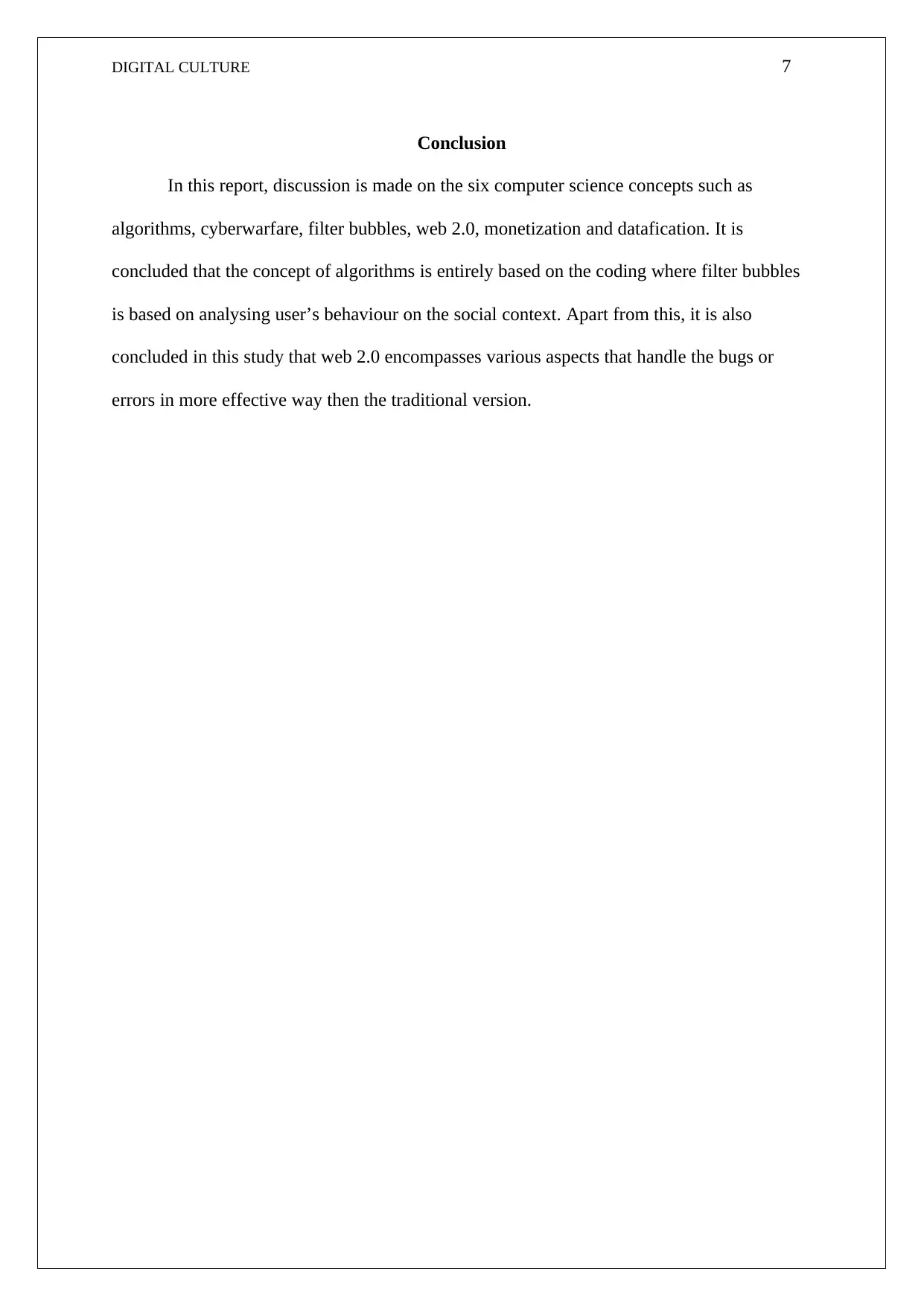
DIGITAL CULTURE 7
Conclusion
In this report, discussion is made on the six computer science concepts such as
algorithms, cyberwarfare, filter bubbles, web 2.0, monetization and datafication. It is
concluded that the concept of algorithms is entirely based on the coding where filter bubbles
is based on analysing user’s behaviour on the social context. Apart from this, it is also
concluded in this study that web 2.0 encompasses various aspects that handle the bugs or
errors in more effective way then the traditional version.
Conclusion
In this report, discussion is made on the six computer science concepts such as
algorithms, cyberwarfare, filter bubbles, web 2.0, monetization and datafication. It is
concluded that the concept of algorithms is entirely based on the coding where filter bubbles
is based on analysing user’s behaviour on the social context. Apart from this, it is also
concluded in this study that web 2.0 encompasses various aspects that handle the bugs or
errors in more effective way then the traditional version.
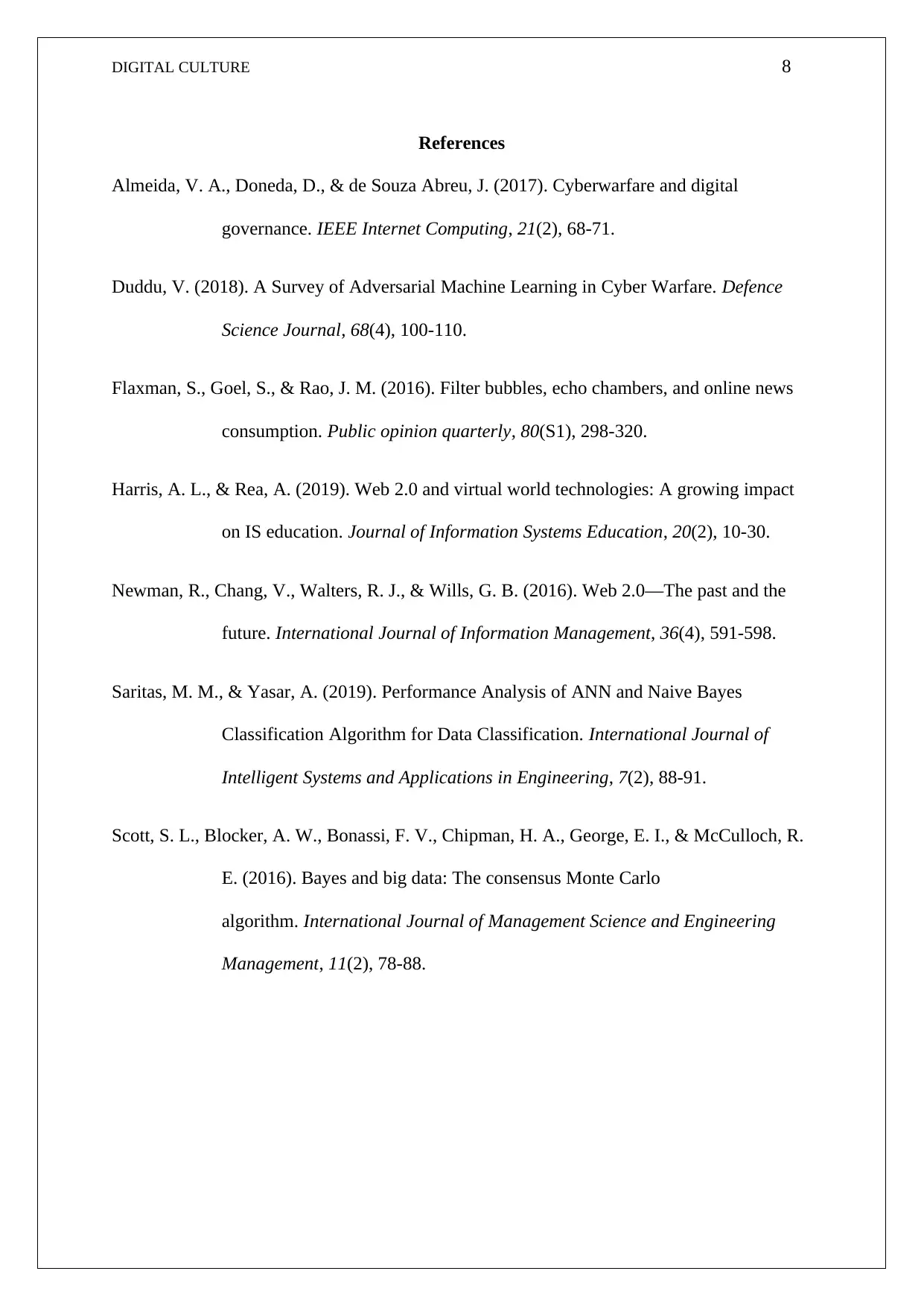
DIGITAL CULTURE 8
References
Almeida, V. A., Doneda, D., & de Souza Abreu, J. (2017). Cyberwarfare and digital
governance. IEEE Internet Computing, 21(2), 68-71.
Duddu, V. (2018). A Survey of Adversarial Machine Learning in Cyber Warfare. Defence
Science Journal, 68(4), 100-110.
Flaxman, S., Goel, S., & Rao, J. M. (2016). Filter bubbles, echo chambers, and online news
consumption. Public opinion quarterly, 80(S1), 298-320.
Harris, A. L., & Rea, A. (2019). Web 2.0 and virtual world technologies: A growing impact
on IS education. Journal of Information Systems Education, 20(2), 10-30.
Newman, R., Chang, V., Walters, R. J., & Wills, G. B. (2016). Web 2.0—The past and the
future. International Journal of Information Management, 36(4), 591-598.
Saritas, M. M., & Yasar, A. (2019). Performance Analysis of ANN and Naive Bayes
Classification Algorithm for Data Classification. International Journal of
Intelligent Systems and Applications in Engineering, 7(2), 88-91.
Scott, S. L., Blocker, A. W., Bonassi, F. V., Chipman, H. A., George, E. I., & McCulloch, R.
E. (2016). Bayes and big data: The consensus Monte Carlo
algorithm. International Journal of Management Science and Engineering
Management, 11(2), 78-88.
References
Almeida, V. A., Doneda, D., & de Souza Abreu, J. (2017). Cyberwarfare and digital
governance. IEEE Internet Computing, 21(2), 68-71.
Duddu, V. (2018). A Survey of Adversarial Machine Learning in Cyber Warfare. Defence
Science Journal, 68(4), 100-110.
Flaxman, S., Goel, S., & Rao, J. M. (2016). Filter bubbles, echo chambers, and online news
consumption. Public opinion quarterly, 80(S1), 298-320.
Harris, A. L., & Rea, A. (2019). Web 2.0 and virtual world technologies: A growing impact
on IS education. Journal of Information Systems Education, 20(2), 10-30.
Newman, R., Chang, V., Walters, R. J., & Wills, G. B. (2016). Web 2.0—The past and the
future. International Journal of Information Management, 36(4), 591-598.
Saritas, M. M., & Yasar, A. (2019). Performance Analysis of ANN and Naive Bayes
Classification Algorithm for Data Classification. International Journal of
Intelligent Systems and Applications in Engineering, 7(2), 88-91.
Scott, S. L., Blocker, A. W., Bonassi, F. V., Chipman, H. A., George, E. I., & McCulloch, R.
E. (2016). Bayes and big data: The consensus Monte Carlo
algorithm. International Journal of Management Science and Engineering
Management, 11(2), 78-88.
⊘ This is a preview!⊘
Do you want full access?
Subscribe today to unlock all pages.

Trusted by 1+ million students worldwide
1 out of 9
Your All-in-One AI-Powered Toolkit for Academic Success.
+13062052269
info@desklib.com
Available 24*7 on WhatsApp / Email
![[object Object]](/_next/static/media/star-bottom.7253800d.svg)
Unlock your academic potential
Copyright © 2020–2025 A2Z Services. All Rights Reserved. Developed and managed by ZUCOL.